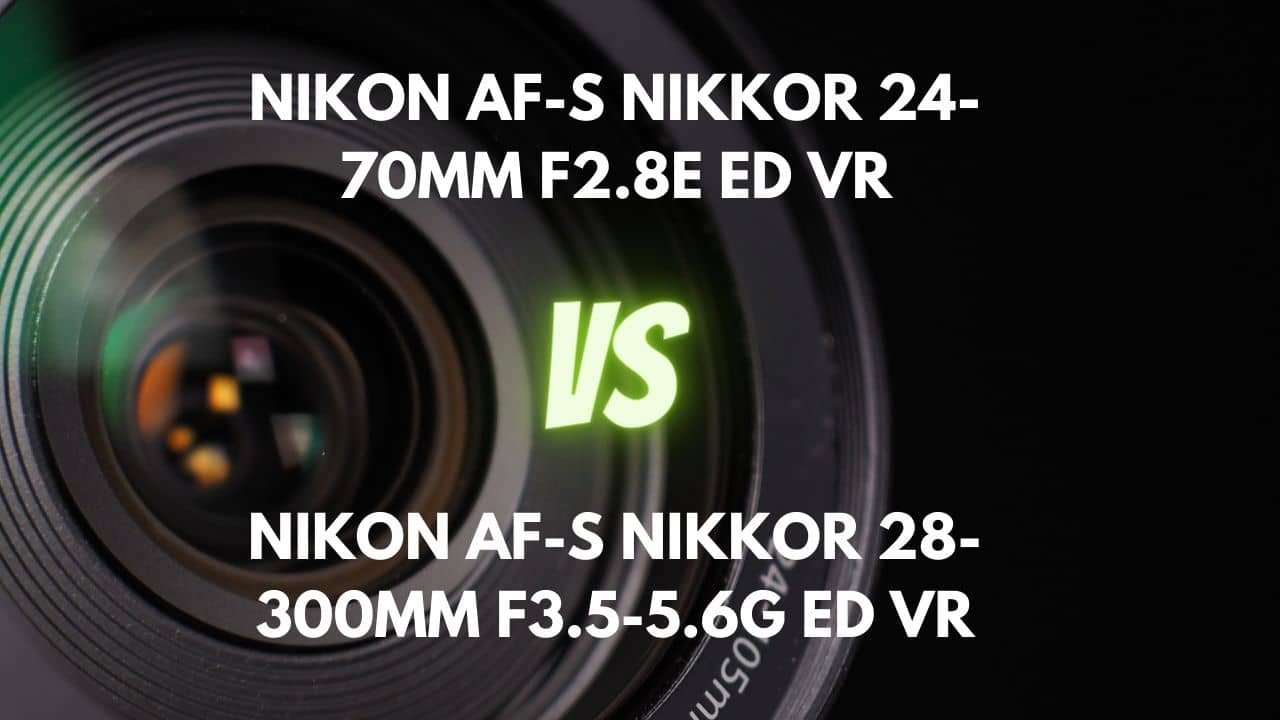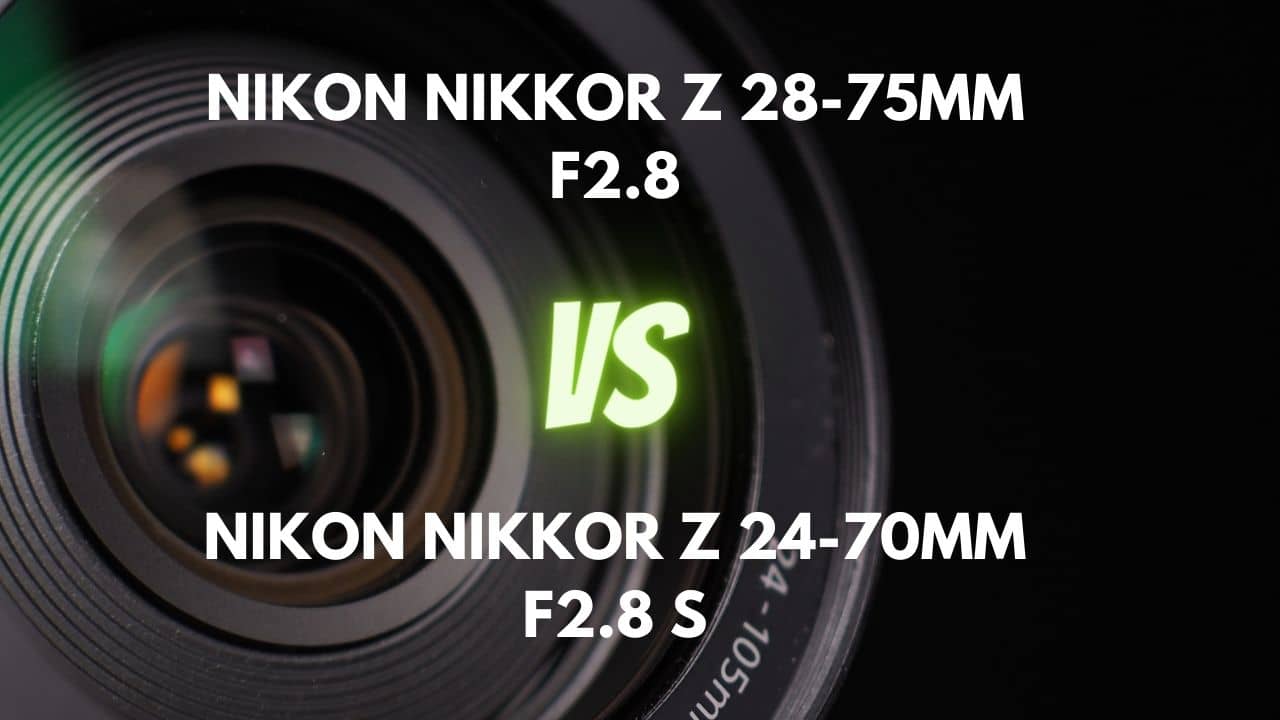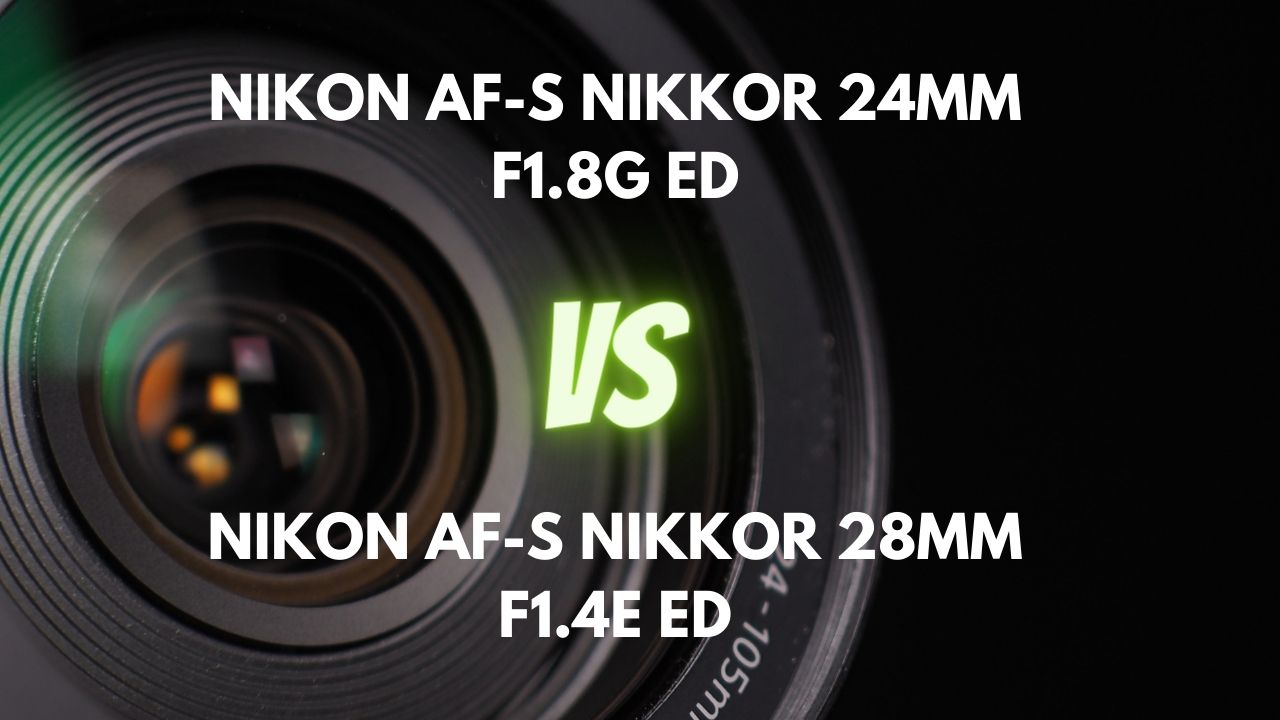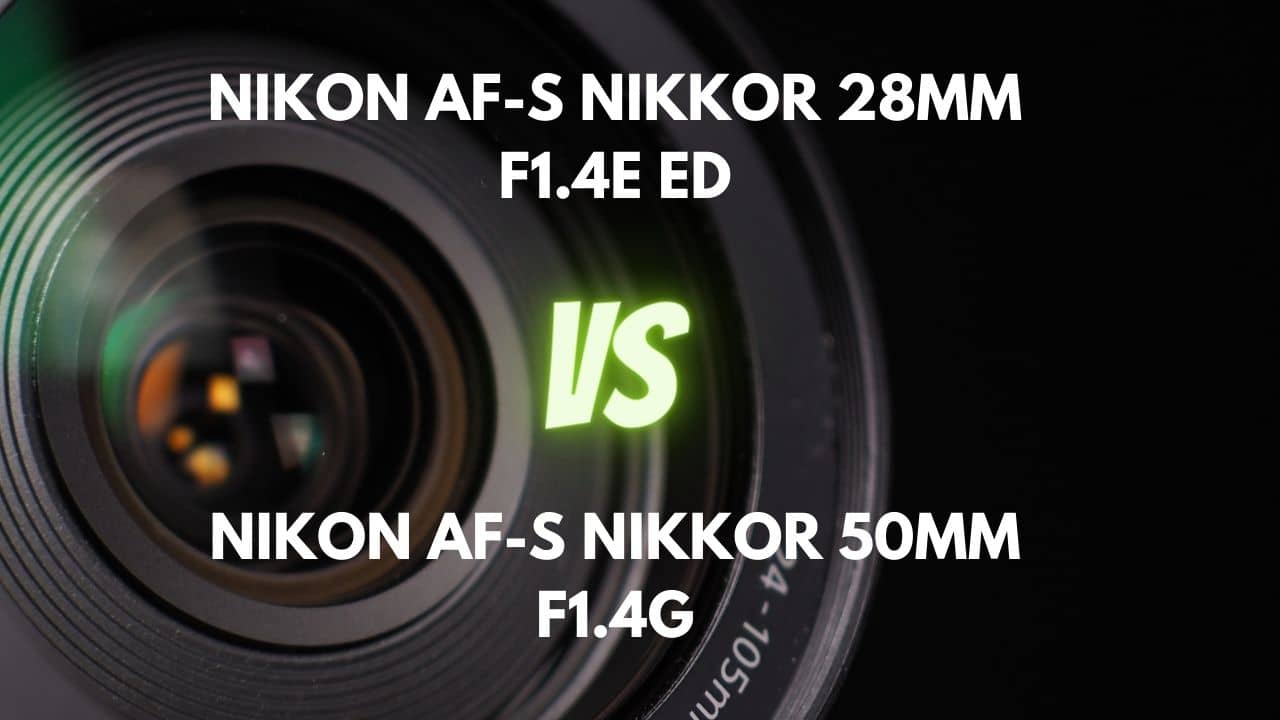In the world of photography, capturing the perfect shot often comes down to choosing the right gear. For enthusiasts and professionals alike, selecting the ideal wide-angle lens can make all the difference in capturing stunning landscapes, breathtaking architecture, or those candid street moments.
That’s why we’ve decided to put two popular contenders to the test: the versatile Nikon 17-35mm f/2.8 and the ultra-wide Nikon 14-24mm f/2.8.
In this in-depth comparison, we’ll explore the strengths and weaknesses of each lens, focusing on aspects such as portability, image quality, sharpness, and distortion control. By understanding the unique features of these lenses, you’ll be better equipped to make an informed decision that caters to your specific photography needs.
So, whether you’re a landscape photographer seeking breathtaking vistas or a street photographer chasing the perfect moment, read on to discover which of these two lenses will elevate your photography game to new heights.
Overview
| Nikon AF-S NIKKOR 17-35mm F2.8D IF-ED | Nikon AF-S NIKKOR 14-24mm F2.8G ED | |
|---|---|---|
| Max Aperture | F2.8 | F2.8 |
| Aperture Type | Fixed | Fixed |
| Focal Range (mm) | 17-35 | 14-24 |
| Max Format | 35mm FF | 35mm FF |
| Zoom Ratio (X) | 2.1 | 1.7 |
Comparing the two camera lenses, the Nikon 17-35mm f/2.8 and the Nikon 14-24mm f/2.8, both have a maximum aperture of f/2.8, which is good for low light performance and depth of field control. They also both have a fixed aperture type, meaning that their maximum aperture remains constant throughout the zoom range. This results in better image quality, low light performance, and more consistent performance across the zoom range compared to variable aperture lenses.
The main difference between the two lenses is their focal range. The 17-35mm has a focal range of 17-35mm with a zoom ratio of 2.1x, making it more versatile for a variety of photography genres, such as landscapes, architecture, and travel. On the other hand, the 14-24mm has a focal range of 14-24mm and a zoom ratio of 1.7x. This lens is better suited for ultra-wide-angle photography, which is ideal for capturing vast landscapes, interiors, or dramatic perspectives.
In conclusion, both lenses have their advantages, and the superior lens depends on your specific photography needs and preferences. If you’re looking for a more versatile lens for various photography genres, the 17-35mm might be the better choice. However, if ultra-wide-angle photography is your primary interest, the 14-24mm lens offers a unique perspective and is likely the superior option.
Design and Ease of Use
| Nikon AF-S NIKKOR 17-35mm F2.8D IF-ED | Nikon AF-S NIKKOR 14-24mm F2.8G ED | |
|---|---|---|
| Diameter x Length (mm) | ⌀82.5×106mm | ⌀98×131.5mm |
| Weight (gr) | 745 | 1000 |
| Filter Thread (mm) | 77 | No Filter Thread |
| Weather Sealing | No | Yes |
| Zoom Method | Rotary (internal) | Rotary (internal) |
| Distance Scale | Yes | Yes |
| DoF Scale | No | No |
| Hood Supplied | Yes | Yes |
| Hood Code | HB-23 | Built-In Hood |
The Nikon 17-35mm f/2.8 has dimensions of ⌀82.5x106mm and weighs 745 grams, making it more compact and lightweight compared to the Nikon 14-24mm f/2.8 with dimensions of ⌀98×131.5mm and a weight of 1000 grams. A more portable lens can provide advantages such as easier transport, better balance, increased discreetness, space-saving storage, and simpler lens swapping.
Both lenses feature an internal rotary zoom method, which offers consistent camera balance while zooming, as well as a more compact design and better weather sealing due to the lack of extension. However, this method may also result in increased complexity and potentially a heavier lens compared to an extending rotary zoom.
In conclusion, the 17-35mm lens is superior in terms of portability and handling, as it is smaller and lighter than the 14-24mm lens. While both lenses employ an internal rotary zoom method, the 17-35mm’s more compact and lightweight design offers better overall usability and convenience, making it a more attractive choice for photographers who value portability and ease of handling.
Lens Mount and Barrel
The Nikon 17-35mm f/2.8 features a metal lens mount with a plastic bayonet and lacks a rubber gasket around the mount, making it potentially less resistant to dust and water ingress. The lens barrel is metal, boasting a semi-matte black sputtered epoxy paint finish, and the lens maintains a constant physical size during zooming due to its internal focusing design.
On the other hand, the lens mount of Nikon 14-24mm f/2.8 is made entirely of metal and has a rubber gasket to seal against dust and water, offering better protection in harsh conditions. The G lever operates the aperture, and the lens does not support gel filters inside the mount. The lens barrel has a texturized metal finish and features plastic zoom and focus rings with ridged rubber coatings for a secure grip. The lens maintains a constant physical length during zooming, but the inner lens tube moves slightly according to the focal length.
Comparing these two lenses, the 14-24mm lens provides better protection against dust and water due to its metal construction and rubber gasket. The 17-35mm lens, although it has a metal barrel, does not provide the same level of protection as it lacks a rubber gasket. In terms of aesthetics and usability, the 14-24mm lens has a more textured metal finish and better grip, while the 17-35mm lens sports a semi-matte finish.
In conclusion, the 14-24mm lens has a superior design compared to the 17-35mm lens, offering better protection against environmental factors and improved usability. While the choice of materials for lens mounts and barrels largely depends on individual preferences and needs, the 14-24mm lens seems to be a more durable and professional option for photographers who value build quality and protection from the elements.
Weather Sealing
The Nikon 17-35mm f/2.8 lacks weather sealing features, as it does not have a gasket at the lens mount or any internal seals at the rings, switches, and front of the barrel. This makes it less suitable for outdoor photography in challenging environments or varying weather conditions, as it might be more prone to damage and wear over time.
In contrast, the Nikon 14-24mm f/2.8 has robust weather sealing, with rubber seals that repel dust, dirt, moisture, and other grime. The metal mount is secure and comes with a rubber gasket to seal against dust and water. Furthermore, internal seals are placed at the rings, switches, and front of the barrel, ensuring better durability and performance in adverse conditions.
Comparing the two lenses, the 14-24mm lens offers superior weather sealing, providing better protection against environmental elements and ensuring optimal performance even in harsh conditions. This lens is ideal for photographers who frequently shoot outdoors or face unpredictable weather, as it offers peace of mind and investment protection.
In conclusion, the 14-24mm lens is the clear winner when it comes to weather sealing, making it a more reliable choice for photographers who require a versatile lens capable of withstanding the challenges of various shooting conditions.
Rings
The Nikon 17-35mm f/2.8 features 2 well-designed control rings: a zoom ring and a focus ring. Both rings operate smoothly, providing precise framing and easy manual focusing. The rings are ergonomically beveled, ensuring comfortable grip and manipulation. Additionally, there is no zoom creep, and the lens has a windowed distance scale for convenience.
On the other hand, the Nikon 14-24mm f/2.8 also has 2 external rings: a 25mm wide zoom ring located close to the camera body and a 15mm wide focus ring just behind the lens hood. Both rings have ridged rubber coatings for a secure grip. The zoom ring takes about a quarter turn to move through the entire focal range and features wider ridges with two notches for added grip security.
The focus ring has a throw of around 50 degrees and offers smooth movement. The lens also includes a windowed distance scale with five settings in meters and feet. However, the lens does not accept filters due to its permanent hood, and the front element moves slightly as you rotate the zoom collar.
Comparing the two lenses, the 14-24mm lens offers better tactile feedback and more distinct grip features, ensuring precise control over focus and zoom adjustments. The 17-35mm lens, however, has a more ergonomic design, which is comfortable to use and provides smooth operation.
Switches/Buttons
The Nikon 17-35mm f/2.8 features a single switch labeled as “M/A – M” which is used for toggling between autofocus and manual focus. In the “M/A” position, the lens operates in autofocus mode while still allowing manual focus adjustments without the need to switch to manual focus mode. There are no other switches or buttons present on the lens.
On the other hand, the Nikon 14-24mm f/2.8 is equipped with a slider switch offering M/A and M settings. This switch allows the user to engage autofocus with manual override or to set the lens for manual focusing. However, the lens does not have built-in image stabilization, so there is no IS switch. Additionally, the lens lacks a focus limiter or any other switches or buttons.
Comparing the two lenses, both offer similar functionality in terms of switches/buttons, with a primary focus on switching between autofocus and manual focus modes. The 14-24mm lens features a slider switch, while the 17-35mm lens has an AF/MF switch.
Filter Thread
The Nikon 17-35mm f/2.8 features a metal 77mm filter thread, which is a versatile and commonly used size. This filter thread doesn’t rotate during focus, making it easy to use with filters, such as the Hoya multicoated HD3 UV filter, which repels dirt and fingerprints. The lens is compatible with standard filters, providing a straightforward way to achieve various filter effects.
In contrast, the Nikon 14-24mm f/2.8 does not have a traditional filter thread, meaning physical filters cannot be attached directly to the lens. However, third-party filter options are available, such as the LEE Filters SW150 Mark II Lens Adapter and the Kase Rear Lens ND Filter Kit. These filters are designed for the Nikon AF-S NIKKOR 14-24mm f/2.8G ED lens, offering photographers a range of filter options.
The LEE Filters adapter allows for the use of 150mm-wide filters, while the Kase ND Filter Kit provides three compatible ND filters for the lens’s built-in rear filter slot. While these solutions can increase the overall size and cost of using the lens, they enable photographers to achieve their desired filter effects with this high-quality lens.
In conclusion, the 17-35mm lens offers a superior filter thread experience due to its compatibility with standard filters and its 77mm filter thread size. The 14-24mm lens requires third-party solutions, which may be less convenient and add to the overall cost.
Lens Hood
The Nikon 17-35mm f/2.8 comes with an included HB-23 plastic bayonet hood, featuring a matte black sputtered epoxy paint finish over alloy. With a simple beveled design, the hood is easy to attach and detach from the lens. However, it does not have a scalloped shape and cannot be smoothly rotated.
On the other hand, the Nikon 14-24mm f/2.8 has a built-in, non-collapsible plastic lens hood with a petal-shaped design. While it does not offer full protection for the lens’s front element at the wide end, it serves as a guard against accidental damage. The hood cannot be rotated or detached.
Focusing and Optical Stabilization
| Nikon AF-S NIKKOR 17-35mm F2.8D IF-ED | Nikon AF-S NIKKOR 14-24mm F2.8G ED | |
|---|---|---|
| Autofocus | Yes | Yes |
| AF Motor | Silent Wave Motor | Silent Wave Motor |
| Rotating Front Element | Does not rotate on focusing | Does not rotate on focusing |
| Min Focus Distance | 0.28m | 0.28m |
| Max Magnification (X) | 0.22 | 0.15 |
| Full-Time Manual Focus | Yes | Yes |
| Focus Method | Internal | Internal |
Focusing Performance
The Nikon 17-35mm f/2.8 boasts a Silent-Wave Drive autofocus system that operates near silently and very fast. Producing almost no noise when focusing, its speed is virtually instantaneous. The lens delivers excellent focus accuracy, easy and sure manual focus, and an internally focusing design, which keeps the length constant at all times. The manual focus action is smooth and continuous, with a manual focus override feature.
In contrast, the Nikon 14-24mm f/2.8 features a ring-type ultrasonic autofocus that is almost silent, with a fast initial autofocus acquisition speed. However, an audible clack is produced with every focus movement during video recording.
The manual focus override allows for instant switching from autofocus to manual focus. While the manual focus action is generally smooth, some users find the relatively short rotational travel of the focus ring a bit fiddly for applications like astrophotography. This lens also has an internally focusing design and performs well in low-light situations, achieving accurate focus and sharp images even at slow shutter speeds.
In conclusion, both lenses offer impressive focusing performance, but the 17-35mm lens has a slight edge due to its near-silent and instantaneous autofocus system. While the 14-24mm lens performs admirably, particularly in low-light situations, the noise during video recording and the less user-friendly manual focus may be less appealing to some users.
Optical Stabilization
Both the Nikon 17-35mm f/2.8 and Nikon 14-24mm f/2.8 lack built-in optical stabilization. However, it’s important to note that optical stabilization is not as crucial for wide-angle lenses as it is for telephoto lenses. Wide-angle lenses are generally less susceptible to camera shake due to their shorter focal lengths and wider fields of view, making the effects of camera shake less noticeable.
Optical stabilization can still be beneficial in specific situations, such as low-light conditions, handheld shooting at slower shutter speeds, or video recording. In these cases, some form of stabilization can help achieve sharper images and smoother footage. Many modern cameras now offer in-body image stabilization (IBIS), which can effectively work with wide-angle lenses to minimize camera shake, even if the lens itself doesn’t have built-in optical stabilization.
Considering the common uses of wide-angle lenses, a tripod is often a more effective tool for achieving stability and sharpness, making optical stabilization less of a priority. In scenarios where handheld shooting is required, a fast lens with a larger aperture may provide a more cost-effective solution for capturing sharp images than relying solely on optical stabilization.
In conclusion, neither the 17-35mm nor the 14-24mm lens offers superior optical stabilization, as both lack this feature. However, given the nature of wide-angle lenses and the availability of alternative stabilization methods, such as IBIS or using a tripod, the absence of optical stabilization in these lenses should not be a deal-breaker when choosing between them.
Image Quality
| Nikon AF-S NIKKOR 17-35mm F2.8D IF-ED | Nikon AF-S NIKKOR 14-24mm F2.8G ED | |
|---|---|---|
| Special Elements | 3 ASPH | 2 ED glass elements, 3 aspherical lenses and 1 Nano Crystal Coat |
| Diaphragm Blades | 9 | 9 |
| Circular Aperture | Yes | Yes |
Aberration
The Nikon 17-35mm f/2.8 exhibits well-controlled chromatic aberration and minimal coma. Coma is only apparent as smeared blobs around bright points of light in the corners when the lens is wide open at 17mm, but it disappears by f/5.6.
On the other hand, the Nikon 14-24mm f/2.8 performs exceptionally well in terms of chromatic aberration, with only negligible to low amounts present throughout most of the aperture range. However, at 24mm and larger apertures, there is a more significant presence of chromatic aberration. Fortunately, this can be corrected with post-processing software or with the built-in chromatic aberration correction in some camera models.
In conclusion, both lenses have their strengths when it comes to aberration control. The 17-35mm lens has minimal coma and well-controlled chromatic aberration, while the 14-24mm lens excels in managing chromatic aberration throughout most of its aperture range, with some exceptions at 24mm and larger apertures.
Sharpness
The Nikon 17-35mm f/2.8 is generally very sharp, even wide open, although the corners struggle on large FX sensors at the short end of the zoom range. Stopping down considerably improves sharpness in the corners, producing very good results. At 35mm, the lens is sharp even in the corners at f/2.8, but diffraction limits performance at f/16 and f/22.
When the aperture is stopped down to f/5.6 or longer focal lengths, the Nikon DX 18-140mm f/3.5-5.6 lens delivers excellent sharpness throughout the entire frame. The optimal aperture for maximum sharpness varies depending on the focal length and aperture setting, but usually ranges from f/4 to f/8.
On the other hand, the Nikon 14-24mm f/2.8 exhibits exceptional sharpness performance, especially at the short end of the zoom range. At 14mm, the lens delivers excellent center and mid-frame performance, with a sweet spot at f/5.6. Corner performance improves when stopped down, and the corners benefit from closing the aperture to f/8 at 24mm.
However, sharpness at the short end displays some astigmatism and a noticeable dip towards the corners. The sharpness is outstanding overall, and the lens is optimized to be sharpest at 14mm. The lens exhibits some focus shift and corner shading, especially at wide-open aperture.
In conclusion, both lenses showcase excellent sharpness, but the 14-24mm lens stands out with its exceptional performance, particularly at the short end of the zoom range. While the 17-35mm lens delivers impressive sharpness across the frame when stopped down, the 14-24mm lens has the edge in terms of overall sharpness and optimization at 14mm. Thus, if sharpness is your primary concern, the 14-24mm lens would be the superior choice.
Bokeh Quality
The Nikon 17-35mm f/2.8 creates fairly good and realistic bokeh, which is neutral to good at ordinary distances at 17mm stopped down. At closer than 2 feet at 35mm, the bokeh seems very neutral. While not specifically mentioned as “smooth and beautiful,” the overall impression is positive and in line with expectations for a professional-grade lens.
On the other hand, the Nikon 14-24mm f/2.8 is not known for producing spectacularly attractive bokeh, which is to be expected for an ultra-wide lens with aspherical elements. Achieving satisfactory results is feasible when capturing subjects at the longest focal length of 140mm, even when shooting up close. The bokeh can be rather nervous due to some amount of outlining.
In conclusion, while bokeh quality is not typically a primary concern for wide-angle lenses, there are instances where it can play a role in certain photography situations. Between the two lenses, the 17-35mm lens produce a more neutral and pleasing bokeh compared to the 14-24mm lens, which has a more nervous and outlined bokeh. If bokeh quality is a factor you’re considering, the 17-35mm lens may be the better choice for your photography needs.
Flare/Ghosting
The Nikon 17-35mm f/2.8 has excellent resistance to flare and ghosting, attributed to its use of aspherical elements. It performs as well as, or even better than, fixed ultra-wide lenses in this regard. Even shooting directly into the sun is not a problem, and if there are any magenta spots visible in the viewfinder, they can easily be blocked out with your hand. The included plastic bayonet hood helps further reduce any potential flare or ghosting.
In contrast, the Nikon 14-24mm f/2.8 is prone to flare and ghosting when shooting against the sun, especially towards the border opposite to the source of light. This is a common issue with most lenses, but the amount of flare produced by this lens can be rather high under such conditions. However, the amount of flare and ghosting can be reduced with the help of coatings like the Nano Crystal Coat, and post-processing software like Lightroom can easily correct the vignetting issues.
In conclusion, the 17-35mm lens exhibits superior performance in terms of flare and ghosting resistance compared to the 14-24mm lens.
Vignetting
The Nikon 17-35mm f/2.8 displays pronounced vignetting, especially at the wide end of the zoom range, but stopping down can reduce it to less noticeable levels. At 17mm, some minor vignetting may still be visible at f/2.8. It’s worth noting that the vignetting analysis was based on uncorrected JPEGs straight from the camera. The lens also performs well with filters and shows no vignetting on DX cameras.
On the other hand, the Nikon 14-24mm f/2.8 exhibits some vignetting, especially at wider focal lengths and larger apertures, but it is easily correctable in post-processing software such as Lightroom. At 14mm and f/2.8, the corner shading can be up to 2 stops darker, but at other focal lengths and aperture combinations, it doesn’t exceed a quarter-stop.
The amount of vignetting is also dependent on the shooting distance and shooting angle relative to the light source. However, some photographers may actually like a little vignetting in their images, and it’s not a major issue with this lens.
In conclusion, the 14-24mm lens has a slight edge in terms of vignetting performance over the 17-35mm lens, as it exhibits less vignetting overall and can be easily corrected in post-processing.
Distortion
The Nikon 17-35mm f/2.8 shows some distortion, especially at the 17mm end where barrel distortion is present. However, it is not a major problem and actually performs better than other lenses in its class. The distortion remains consistent across all distances, unlike some fixed focal length lenses where the distortion worsens at close distances. The distortion can be corrected using software, but it may not be perfect due to the complexity of some of the distortion.
In contrast, the Nikon 14-24mm f/2.8 exhibits barrel distortion at the widest focal length of 14mm, which gradually decreases as you zoom in and becomes barely perceptible at 24mm. However, even a slight tilt of the camera can produce exaggerations that are typical of ultra-wide lenses, particularly at the 14mm setting. Nonetheless, distortion is correctable in post-processing software, and the lens performs well for landscape photography.
In conclusion, both lenses exhibit distortion, but the 14-24mm lens has a slight advantage in terms of distortion control as it becomes less noticeable when zooming in. If you prioritize minimizing distortion in your photography, the 14-24mm lens would be the better choice. However, both lenses offer decent distortion performance for their class and can be corrected in post-processing software if needed.
Final Verdict
In conclusion, both the Nikon 17-35mm f/2.8 and Nikon 14-24mm f/2.8 have their merits, and the superior choice depends on your specific photography needs, preferences, and budget.
The 17-35mm lens offers better portability, handling, more pleasing bokeh, and slightly better focusing performance, making it a versatile option for various photography genres. On the other hand, the 14-24mm lens excels in sharpness, weather sealing, build quality, vignetting, and distortion control, making it a more professional and durable option, particularly for ultra-wide-angle photography.
However, it’s important to consider that the 14-24mm lens is significantly more expensive than the 17-35mm lens. If budget is a primary concern, the 17-35mm lens offers an excellent balance of performance and affordability.
If you’re willing to invest more for top-notch quality and performance, and your primary interest lies in ultra-wide-angle photography, the 14-24mm lens is the superior choice. Ultimately, the decision should be based on a careful assessment of your priorities, shooting requirements, and financial constraints.






